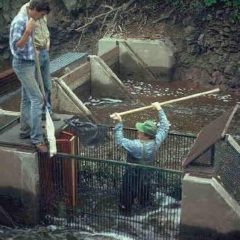
The French River Cold Water Hatchery, located on Lake Superior two miles north of Duluth, needs $8 million in capital investment to address failing equipment, according to the DNR. It also consumes 10 percent of the energy used by the agency statewide.
A hatchery was first established at the location in 1919, originally known as the Lake Superior State Fish Hatchery. The French River Cold Water Hatchery was built in 1975 to conduct the majority of fish propagation. Since 1962, the DNR and U.S. Fish and Wildlife Service have planted about 300,000 six-inch lake trout along the North Shore each year, resulting in a 250 percent increase in lake trout netted during surveys, according to the DNR.
From the news release:
Fisheries Chief Don Pereira said energy inefficiency and costly repairs make it necessary to close the hatchery, but the remaining fish production from French River will be continued elsewhere.
“We remain strongly committed to providing great fishing opportunities in Lake Superior and along the North Shore,” Pereira said. “To provide the best fishing we can for anglers, we need to be strategic about how we use energy, and we’re confident we can adjust to meet angler needs with our remaining four hatcheries.”
Pereira said production of Kamloops trout, which are raised at French River and stocked in Lake Superior, will be moved to another hatchery. The Kamloops trout is a domesticated strain of rainbow trout that cannot reproduce in the lake.
“Kamloops provide a popular near-shore fishery for Lake Superior anglers,” Pereira said. “We will continue to produce Kamloops at another nearby hatchery until an agreed-upon strategy is reached with the Lake Superior Advisory Group, a group of anglers who work with the DNR on Lake Superior issues.”
Under current French River operations, each Kamloop an angler keeps costs approximately $160 to produce. The hatchery is inefficient because it uses Lake Superior’s cold water and must heat the water to a temperature at which fish can be raised, a process that is less costly elsewhere.
The French River hatchery was built in the 1970s to aid in the restoration of lake trout in Lake Superior, which at the time depended heavily on stocked fish. Today, wild lake trout have staged a healthy recovery in Lake Superior, which means the agency no longer needs to stock the fish in the big lake.
The hatchery also produced steelhead trout, which also now have self-supporting wild populations and each year make runs up North Shore streams.
The advisory group most recently met to give input about the soon-to-be finalized Lake Superior management plan. Pereira said closure of the French River hatchery is consistent with that plan.
The DNR’s four hatcheries produce trout that are stocked in a variety of lakes throughout the state, with an inland water summer season that closed on Halloween and a winter season that opens in mid-January. A list of trout lakes can be found on the DNR website.